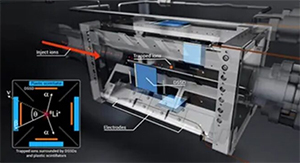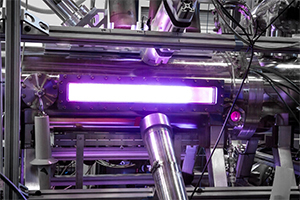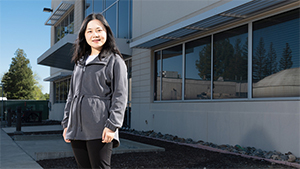LAB REPORT
Science and Technology Making Headlines
April 26, 2024


Radioactive ions from the ATLAS accelerator at Argonne National Laboratory are suspended in vacuum using an ion trap device.
May the weak nuclear force be with you
The Standard Model of Particle Physics offers a better understanding of the forces that describe the interaction between subatomic particles. The strong nuclear force, weak nuclear force, electromagnetic force and gravity are the four fundamental forces that define our universe and are described by the Standard Model.
Strong forces generally have far bigger impacts than weak nuclear forces, making it difficult to study them.
In a new study, researchers from Louisiana State University, Argonne National Laboratory and Lawrence Livermore National Laboratory aim to enhance our understanding of the weak nuclear force by analyzing beta decays of “mirror” nuclei, such as lithium-8 and boron-8. In mirror nuclei, the number of protons and neutrons is the same, but their arrangement is different. For example, lithium-8 has three protons and five neutrons, but boron-8 has five protons and three neutrons.
The study’s findings produced the most precise measurements and more confidently validated the Standard Model’s predictions.


A bright flash of light from a FuZE (Fusion Z-pinch Experiment) plasma. Image courtesy of Zap Energy.
Pinch me, it’s hot in here
In the nine decades since humans first produced fusion reactions, only a few fusion technologies have demonstrated the ability to make a thermal fusion plasma with electron temperatures hotter than 10 million degrees Celsius, roughly the temperature of the core of the sun.
Zap Energy’s unique approach, known as a sheared-flow-stabilized Z pinch, has now joined those rarefied ranks, far exceeding this plasma temperature milestone in a device that is a fraction of the scale of other fusion systems.
A new research paper, published this month in Physical Review Letters and including Lawrence Livermore authors, details measurements made on Zap Energy’s Fusion Z-pinch Experiment (FuZE) of 1-3 keV plasma electron temperatures — roughly the equivalent of 11 to 37 million degrees Celsius (20 to 66 million degrees Fahrenheit).
FuZE was originally funded for research at the University of Washington by the U.S. Department of Energy’s Advanced Research Projects Agency – Energy (ARPA-E). The device moved to Zap Energy’s dedicated R&D facilities in 2020, soon after the company was founded. The results in this paper were collected in 2022 in an ARPA-E funded collaboration with researchers from Lawrence Livermore National Laboratory and University of California, San Diego, who spearheaded the development of the measurement system used for these results.


Opportunistic pathogenic species, such as acinetobacter, are prevalent in combat wound infections and commonly found on the gear of U.S. military service members. Image by Adobe Stock.
Improving care for military service members
The severely invasive nature of combat trauma creates massive regions of injury, colonization and infection, requiring specialized diagnostic and aggressive therapeutic approaches. Previous reports indicate an estimated occurrence of wound infections in 18%–25% of combat-related injuries.
Hindering wound recovery are multidrug-resistant microorganisms, which have been consistently observed in injured service members with reports throughout the recent conflicts in Iraq and Afghanistan.
To support the early detection of potentially detrimental microbial factors, researchers at Lawrence Livermore National Laboratory (LLNL) have developed a targeted panel for the capture and sequencing of microbial genomic signatures relevant to wounds from combat injuries.
“Generating these datasets and analytical approaches results in a clearer picture of microbes associated with military injury and their impact on health outcomes,” said LLNL scientist Nicholas Be. “We’re focused on developing and further applying these platforms to effectively predict risks and improve care for military service members.”

Lyme disease is an infectious bacterial infection that is spread by ticks, characterized by a distinctive, expanding 'bullseye' redness and swelling around the site of the tick bite. Photograph by Centers for Disease Control and prevention.
Lyme disease patients could get some relief
Scientists may have found a way to effectively counter the neurological symptoms of Lyme disease.
A new study led by Tulane National Primate Research Center, School of Medicine assistant professor Geetha Parthasarathy and edited by Lawrence Livermore National Laboratory's Amy Rasley presents a novel discovery that could help pave the way for potential treatments for Lyme disease symptoms, particularly the ones stemming from persistent neuroinflammation.
The study, published in Frontiers of Immunology, zeroed in on fibroblast growth factor receptor inhibitors that are commonly used in cancer treatment. The team learned that the cancer treatment component could effectively reduce the manifestations of neurological symptoms in patients struggling with post-treatment Lyme disease syndrome.
Post-treatment Lyme disease syndrome is a condition marked by the lingering symptoms of the disease after antibiotic treatment. The symptoms are mostly neurological and include memory loss, fatigue and pain.


LLNL scientist Wenyu Sun is studying electrodes on vanadium redox flow batteries to extend the life for use in stationary grid energy storage. Photo by Blaise Douros/LLNL.
Going with the flow
As a grid-scale energy storage system, flow batteries have gained increasing attention as a means to address the challenges associated with fluctuations and intermittency in renewable energy sources.
Vanadium redox flow batteries (VRFBs) have emerged as promising solutions for stationary grid energy storage due to their high efficiency, scalability, safety, near-room-temperature operation conditions and the ability to size power and energy capacities independently. The redox reactions in a redox flow battery occur at the surfaces of the electrodes in contact with the electrolyte. Any modifications to the electrode surface can affect the electrochemical activity and affect the overall battery performance.
In an effort to extend the lifespans of VRFBs, Lawrence Livermore National Laboratory scientists and collaborators from Pacific Northwest National Laboratory have explored the surface functionality of carbon electrodes and their propensity for degradation during electrochemical cycles.





